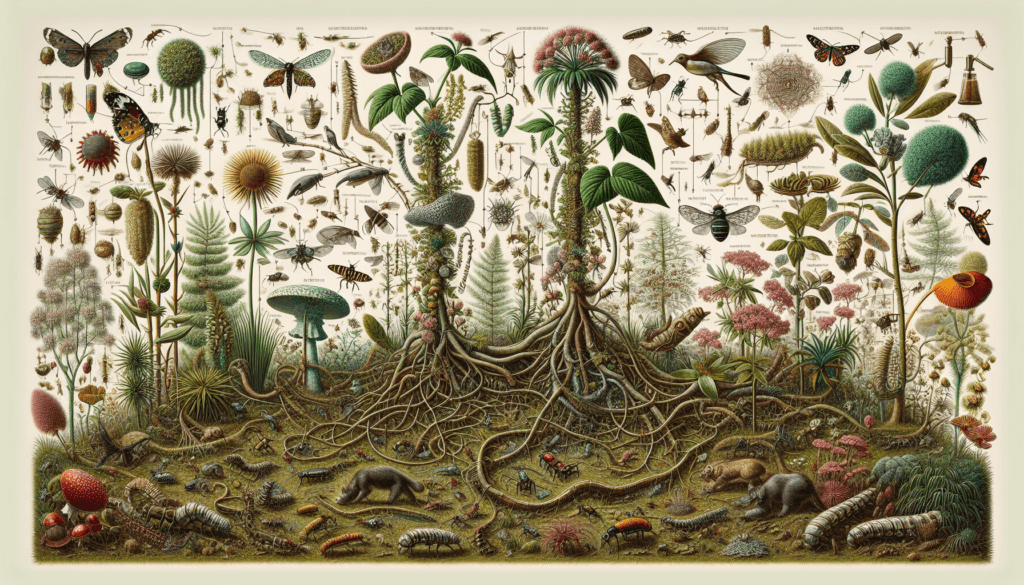Imagine a world where plants are not simply a part of an ecosystem, but rather the entire ecosystem itself. In this captivating article, we explore the idea of plants as the fundamental building blocks of an ecosystem, highlighting their crucial role in sustaining life on Earth. Delve into the intricate relationships between plants, animals, and the environment, and discover the fascinating interconnectedness that makes plants truly remarkable. Step into this captivating exploration and uncover the incredible world of plants as an ecosystem all on their own.
What is an Ecosystem?
An ecosystem refers to a complex network of living organisms, their physical environment, and the interactions between them. It can be as small as a pond or as vast as a rainforest. Ecosystems encompass diverse communities of plants, animals, microorganisms, and their surrounding habitats. Understanding the components and dynamics of ecosystems is crucial for comprehending the intricate balance of nature.
Definition
The term “ecosystem” was coined by British ecologist Sir Arthur Tansley in 1935, who defined it as “a system resulting from the integration of living organisms and their environment, functioning as a unit.” This definition highlights the interconnectedness of organisms and their environment, emphasizing the importance of studying ecosystems as a whole rather than isolated components.
Components of an Ecosystem
Ecosystems consist of biotic (living) and abiotic (non-living) components. Biotic components include plants, animals, fungi, and microorganisms that interact with each other, while abiotic components comprise the physical environment, such as soil, water, sunlight, and climate. These components work together in a complex web of interactions, forming the foundation of an ecosystem’s functioning.
Role of Plants in Ecosystems
Plants play a vital role in maintaining the balance and functioning of ecosystems. They are not only the primary producers, but they also provide crucial ecological services and serve as habitat and shelter for numerous organisms.
Photosynthesis
One of the key roles of plants in ecosystems is photosynthesis, the process by which they convert sunlight, water, and carbon dioxide into oxygen and glucose. This process not only supports their own growth and survival but also contributes to the oxygen production that sustains all life forms. Without photosynthesis, the entire ecosystem would collapse.
Primary Producers
Plants are the primary producers in ecosystems, meaning they are capable of producing and storing energy through photosynthesis. They form the foundation of the food chain, providing nourishment to herbivores and serving as a source of energy for carnivores and omnivores. Without plants, the entire food web would crumble, leading to the collapse of ecosystems.
Habitat and Shelter for Other Organisms
Plants provide vital habitats and shelter for a wide range of organisms. Their lush foliage, complex root systems, and diverse structures create niches for animals, insects, and microorganisms to thrive. Trees, for example, provide nesting sites for birds, while plants with broad leaves offer shade and shelter for smaller organisms. The diversity of plants within an ecosystem directly influences the diversity of animal species that can inhabit it.

Types of Ecosystems
Ecosystems can be broadly categorized into two main types: terrestrial ecosystems, which are found on land, and aquatic ecosystems, which are found in water bodies.
Terrestrial Ecosystems
Terrestrial ecosystems include forests, grasslands, savannas, deserts, tundra, and many more. These ecosystems are characterized by a rich variety of plant and animal life, adapted to the specific conditions of each habitat. Terrestrial ecosystems are vital for carbon sequestration, soil conservation, and providing habitats for a wide range of organisms.
Aquatic Ecosystems
Aquatic ecosystems encompass both freshwater and marine systems, including lakes, rivers, wetlands, coral reefs, and oceans. These ecosystems are home to a diverse range of aquatic plants and organisms, from algae to fish to marine mammals. Aquatic ecosystems play a crucial role in maintaining global water quality, regulating climate patterns, and supporting a significant portion of the Earth’s biodiversity.
Plant Interactions within Ecosystems
Plants within ecosystems interact with each other and with other organisms in various ways, shaping the dynamics and balance of the entire system.
Competition for Resources
Competition for resources, such as light, water, and nutrients, is a common phenomenon among plants in ecosystems. Plants compete for these limited resources to ensure their survival and reproductive success. This competition drives the evolution of different adaptations and strategies, shaping the structure and diversity of plant communities within an ecosystem.
Symbiotic Relationships
Plants also engage in symbiotic relationships with other organisms, where both parties benefit. One example is mutualism, where plants and certain animals, such as pollinators, form a mutually beneficial relationship. Pollinators, such as bees and butterflies, assist in the plants’ reproduction by transferring pollen between flowers, while the plants provide nectar and pollen as a food source for the pollinators.
Predator-Prey Interactions
While plants are often seen as the prey in ecosystems, they can also serve as the predators. Carnivorous plants, such as the Venus flytrap, capture and consume insects as an additional nutrient source. These predator-prey interactions contribute to the balance of plant populations and the overall biodiversity of ecosystems.

Ecological Services Provided by Plants
Plants provide several crucial ecological services that are essential for the well-being of both ecosystems and human societies.
Oxygen Production
Through the process of photosynthesis, plants are responsible for producing the majority of the Earth’s oxygen. This oxygen is vital for the survival of all aerobic organisms, including humans. Without plants, atmospheric oxygen levels would rapidly decline, leading to catastrophic consequences for life on Earth.
Carbon Sequestration
Plants play a significant role in mitigating climate change by acting as carbon sinks. They absorb carbon dioxide from the atmosphere during photosynthesis and store it as carbon in their biomass and in the soil. This carbon sequestration helps regulate the global carbon cycle and mitigates the greenhouse effect, thereby reducing the impact of climate change.
Soil Conservation
The roots of plants bind the soil, preventing erosion and maintaining its structure and fertility. Plants act as natural barriers against wind and water erosion, helping to retain valuable topsoil and preventing sediment runoff into water bodies. This soil conservation function is crucial for maintaining healthy ecosystems, agricultural productivity, and water quality.
Challenges for Plants in Ecosystems
Plants in ecosystems face numerous challenges, some of which are exacerbated by human activities. These challenges pose significant threats to plant populations and the overall functioning of ecosystems.
Climate Change
Climate change, primarily driven by human activities, poses a significant threat to plants in ecosystems. Rising temperatures, altered precipitation patterns, and extreme weather events can disrupt the delicate balance of ecosystems. Plants may face challenges such as reduced water availability, increased pest and disease pressure, and the loss of suitable habitats.
Habitat Loss
The destruction and fragmentation of natural habitats due to activities like deforestation, urbanization, and agricultural expansion threaten the survival of many plant species. Habitat loss not only directly affects plants but also disrupts the intricate relationships between plants and the organisms that depend on them. It can lead to the decline and extinction of plant species, resulting in a loss of biodiversity.
Invasive Species
The introduction of non-native species into ecosystems can have devastating effects on plant communities. Invasive species often outcompete native plants for resources, disrupt ecological processes, and alter the structure and composition of ecosystems. They can negatively impact plant populations and reduce the overall resilience of ecosystems to environmental changes.

Human Impacts on Plant Ecosystems
Human activities have significantly impacted plant ecosystems, often leading to degradation and loss of biodiversity.
Deforestation
Deforestation, driven by agricultural expansion, logging, and urbanization, is a major threat to plant ecosystems worldwide. Large-scale clearing of forests not only results in the loss of valuable plant species but also disrupts the countless ecological services provided by forests, such as carbon sequestration, water regulation, and habitat provision for both plants and animals.
Pollution
Pollution, including air and water pollution, has detrimental effects on plant ecosystems. Air pollutants, such as acid rain and smog, can damage plant tissues, inhibit photosynthesis, and reduce plant growth and reproductive success. Water pollution, caused by industrial discharge, agricultural runoff, and improper waste disposal, can contaminate water bodies, leading to the death of aquatic plants and the disruption of entire ecosystems.
Overfishing
Overfishing in aquatic ecosystems can have cascading effects on plant ecosystems. The removal of large predatory fish, for example, can trigger an overabundance of smaller herbivorous fish, leading to the overgrazing of aquatic plants. This overgrazing negatively impacts plant populations and disrupts the balance of these fragile ecosystems.
Conservation and Restoration of Plant Ecosystems
Efforts to protect and restore plant ecosystems are crucial for preserving biodiversity and ensuring the long-term sustainability of our planet.
Protected Areas
Establishing protected areas, such as national parks, nature reserves, and wildlife sanctuaries, is a key strategy for conserving plant ecosystems. These protected areas provide safe havens for plant species, safeguarding their habitats from destructive human activities and allowing ecosystems to thrive without disturbance.
Reforestation Programs
Reforestation initiatives play a vital role in restoring plant ecosystems that have been degraded or destroyed. By planting trees and restoring native vegetation, reforestation programs help combat deforestation, enhance wildlife habitat, and contribute to carbon sequestration. These efforts promote the regeneration of plant communities and increase the resilience of ecosystems.
Invasive Species Control
Efforts to control and manage invasive species are essential for protecting plant ecosystems. Monitoring and early detection of invasive species allow for prompt action to prevent their establishment and spread. Control measures, such as manual removal, biological control methods, and targeted herbicide use, can help mitigate the negative impacts of invasive species on plant communities.

Plant Diversity and Ecosystem Resilience
Plant diversity is crucial for the resilience and functioning of ecosystems. An abundance of plant species ensures a wide range of genetic resources, increasing the adaptability and resilience of ecosystems to environmental disturbances.
Importance of Biodiversity
Biodiversity refers to the variety of plant, animal, and microbial species present in an ecosystem. The presence of diverse plant species within an ecosystem provides numerous benefits, such as increased resistance to pests and diseases, improved nutrient cycling, and greater ecosystem stability. Additionally, high plant diversity enhances ecosystem productivity and resilience in the face of environmental changes.
Effects of Plant Loss on Ecosystems
The loss of plant species within an ecosystem can have cascading effects on other organisms and the overall ecosystem functioning. Reduced plant diversity can lead to imbalances in nutrient cycling, disruption of food chains, and decreased habitat availability. These impacts can ultimately result in the decline of animal populations, reduced ecosystem productivity, and a decrease in overall ecosystem resilience.
Future of Plant Ecosystems
The future of plant ecosystems depends on our collective efforts to address the challenges they face and adopt sustainable practices.
Climate Change Adaptation
Adapting to climate change is crucial for the survival and persistence of plant ecosystems. Promoting the use of climate-resilient plant species, improving water management, and implementing sustainable land management practices are essential strategies for mitigating the impacts of climate change on plant communities.
Sustainable Land Management
Adopting sustainable land management practices, such as agroforestry, organic farming, and responsible land-use planning, can help preserve and restore plant ecosystems. These practices promote soil conservation, reduce the use of harmful chemicals, and protect natural habitats. By prioritizing the sustainable use of land, we can ensure the continued health and vitality of plant ecosystems.
In conclusion, plants are not only an integral part of ecosystems but are ecosystems themselves. They provide numerous ecological services, support diverse communities of organisms, and play a crucial role in maintaining the balance and functioning of our planet. However, plants face numerous challenges, mainly due to human activities. Conservation efforts and sustainable practices are essential to protect and restore plant ecosystems, ensuring their resilience for future generations. By recognizing the importance of plants and taking collective action, we can safeguard the invaluable ecosystems that plants create and sustain.



